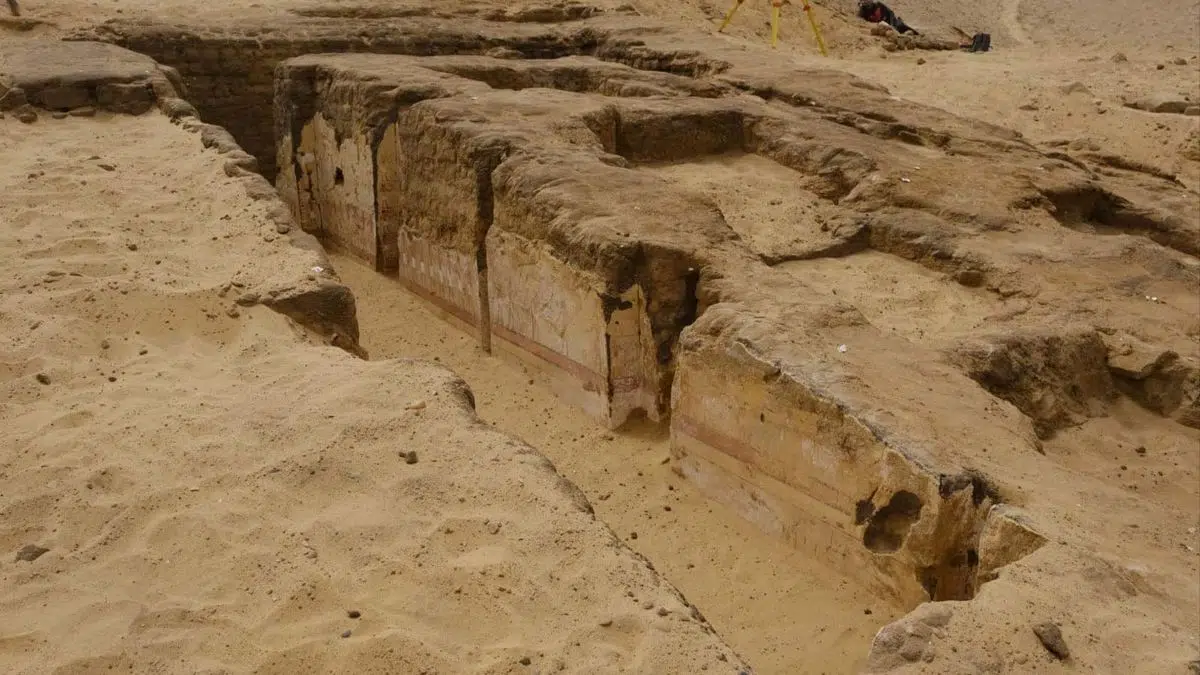
Colorful paintings of everyday life in ancient Egypt have been discovered in a mastaba tomb dating back more than 4,300 years. These were identified in the pyramid necropolis of Dahshur around 25 miles south of Cairo during a recent Egyptian-German archaeological scheme.
Dahshur is the southernmost of the great pyramid necropolises of the Old Kingdom in the region of the ancient capital of Memphis. The central attractions of the vicinity are two large pyramids of King Sneferu, known as the Bent Pyramid and Red Pyramid.
Built out of unfired mud brick, the mastaba measures around 26 feet by 39 feet (8 meters by 12 meters) and comprises seven burial shafts, as well as another shaft for ceramic bowls and other objects used in burial rituals.
4,300-year-old Egyptian tomb with stunning wall paintings was burial place of priestess and royal official
Archaeologists in Egypt have discovered a 4,300-year-old tomb with remarkable wall paintings illustrating everyday life. The tomb is located at Dahshur, a site with royal… pic.twitter.com/4QHtrdPmkc
— Cameron Harris (@cameronh70ne) March 25, 2024
Background of the ancient Egyptian tomb
Per inscriptions etched into a huge limestone false door, the tomb of ancient Egypt belonged to Seneb-nebef, a man who served in the administration of the inhabitants of the palace district, as well as his wife, Idut.
The inscriptions, images, and ceramics found within the tomb, as well as its shape, suggest it dates back to the end of the 5th or beginning of the 6th dynasty. This would be roughly around 2,300 BC.

The expedition was led by Stephan Seidlmayer, the former director of the German Archaeological Institute in Berlin, who told CNN: “The corridor and the cult chamber were decorated with subtle paintings on mud plaster—a rarity in the necropolis of Dahshur. Despite extensive destruction, numerous images have been preserved. They show pictures of the tomb owner and his wife in front of the offering table, scenes from daily life—donkeys on the threshing floor, ships on the Nile, a market place—and servants who bring gifts for the mortuary cult.”
“In their elegant forms and perfect execution, the pictures offer valid evidence of the artistic milieu of the capital region of the developed Old Kingdom,” Seidlmayer concluded.
According to a statement from Egypt’s Ministry of Tourism and Antiquities, inscriptions revealed that the owner of the ancient tomb “held several positions in the royal palace in the administration of tenants,” while his wife “held the titles of Priestess of Hathor and Lady of the Sycamore.”
The German Archaeological Institute Cairo has been excavating in Dahshur since 1976. The first stages centered on the pyramids of King Sneferu from the Old Kingdom and King Amenemhat III from the Middle Kingdom.
The more recent excavations have focused on the tombs of renowned statesmen, priests, and administrators from the same time period.
Seidlmayer and his archaeological team will keep excavating the site “in an attempt to search for more secrets of this area,” the Egyptian Ministry of Tourism and Antiquities said in its statement. It added that “cleaning and documentation work will be carried out on the tomb and its inscriptions during the coming period.”
See all the latest news from Greece and the world at Greekreporter.com. Contact our newsroom to report an update or send your story, photos and videos. Follow GR on Google News and subscribe here to our daily email!



